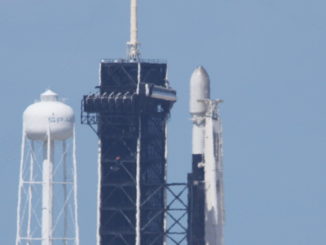
Crews working on Virginia’s Eastern Shore this week raised a top secret payload for the National Reconnaissance Office — the U.S. government’s spy satellite agency — atop a solid-fueled Minotaur 4 rocket for liftoff July 15 on the first Minotaur launch in nearly three years.
Contained inside the Minotaur’s aerodynamic launch shroud, the NRO payload was craned on top of the Minotaur 4 rocket Thursday on pad 0B at the Mid-Atlantic Regional Spaceport. The milestone capped assembly of the 78-foot-tall (23.8-meter) Minotaur 4 launcher as teams prepare for avionics checkouts and a mission dress rehearsal.
Workers from Northrop Grumman, the Minotaur rocket’s contractor, will also install ordnance and prepare the rocket for arming.
Launch of the Minotaur 4 rocket is scheduled for July 15 during a window opening at 9 a.m. EDT (1300 GMT), officials told Spaceflight Now. The exact duration of the launch window has not been released.
NASA’s Wallops Flight Facility plans to provide a live video webcast of the Minotaur 4’s liftoff July 15, but officials are not opening the NASA Visitor Center at Wallops for launch viewing or hosting media representatives to cover the launch in person. NASA cited the coronavirus pandemic as the reason for the closure.
Codenamed NROL-129, the mission will deliver the NRO’s payload into orbit after launching on a southeasterly track from the Mid-Atlantic Regional Spaceport, located at NASA’s Wallops Flight Facility on Virginia’s Eastern Shore.
The Air Force awarded Northrop Grumman a $38 million contract to launch the NROL-129 mission, military officials confirmed in early 2019. Launch services for the NROL-129 mission were arranged through the Air Force’s Orbital/Suborbital Program-3 contract.
Thursday’s installation of the NROL-129 payload on top of the Minotaur 4 rocket was the final step in stacking the launch vehicle. In recent weeks, Northrop Grumman technicians built up the Minotaur 4 rocket on the launch pedestal at pad 0B.

The launch team first stacked the three lower stages of the Minotaur 4 rocket, each coming from stockpiles left over from the Air Force’s retired nuclear-tipped Peacekeeper missiles. The rocket motors were filled with pre-packed solid fuel decades ago, then placed on alert in missile silos until the military decommissioned the Peacekeeper.
The Minotaur 4’s fourth stage is a Orion 38 solid rocket motor produced commercially by Northrop Grumman. The Orion 38 upper stage will inject the NROL-129 payload into its planned orbit.
The launch scheduled for July 15 will mark the first flight of a Minotaur rocket since a Minotaur 4 launch from Cape Canaveral in August 2017. Without a waiver, U.S. government policy requires the Minotaur rocket family only be used to launch military and intelligence-gathering satellites.
The policy is intended to keep government-furnished equipment, such as the retired Peacekeeper stages, from competing with privately-developed rockets in the small satellite launch market.
The Minotaur 4 rocket can carry payloads of up to 3,814 pounds (1,730 kilograms) into low Earth orbit, according to Northrop Grumman.
The last launch of a Minotaur rocket from Wallops Island was on Nov. 19, 2013, when a Minotaur 1 rocket — using Minuteman missile motors — took off with a cluster of small military research and technology demonstration satellites.
Pad 0B in Virginia has been the starting point for six Minotaur launches — five using Minotaur 1 rockets based on the Air Force’s Minuteman missile, and one with the Peacekeeper-derived Minotaur 5 booster, which adds a fifth stage on top of the Minotaur 4.

Minotaur rocket variants using decommissioned Peacekeeper missile motors have launched seven times since 2010 from sites in Virginia, California, Alaska and Florida, all successfully. Five of those launches carried satellites into orbit, and two were experimental suborbital flights.
Launch pad 0B is situated about a quarter-mile south of the other two orbital-class launch sites at Wallops.
Northrop Grumman’s Antares rocket launches from pad 0A on resupply missions to the International Space Station, and Rocket Lab is preparing for the first launch of its Electron small satellite launcher from an adjacent facility named Launch Complex 2.
Email the author.
Follow Stephen Clark on Twitter: @StephenClark1.



